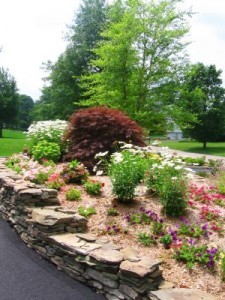Flowers enhance the natural beauty of a yard by integrating color and character. Yet it’s important to understand the difference between the types of flowers and how these differences will affect the look of your yard.
Types of Flowers
Let’s define the various types of flowers that are available.
Annual: An annual flower grows from seed, blooms and lives its life for one season. When the growing season ends, the flower dies and needs to be replanted in the spring. Examples of annuals include petunias and marigolds. Annuals tend to be colorful and vibrant and last from spring through fall.
Perennial: Perennials live for several seasons, so they are a nice investment for the yard. They tend to only bloom for a few weeks out of the season, and they will need periodic replacements over time, generally every 3 to 5 years. When they aren’t bloomed, perennials add stable green growth to the yard. Examples include begonias and dahlias.
Biennial: When a biennial is planted, it spends its first year reproducing. It lives over the winter and then blooms in the second season. Once the seed has set, biennials die off. Examples of biennials include foxgloves and hollyhocks. Biennials are a great way to create seeds to be collected for future planting and growth.
Balancing Your Lawn
When planting flowers, it’s best to have a variety of flowers. Since annuals bloom through the entire season, you will get most of your color from these flowers. Just know that you will have to replace them next spring; but this can be fun since your yard will continually change.
Since perennials only bloom for a few weeks, they don’t offer as much color. However, these flowers tend to be amazingly unique when they do bloom, which is why they’re worth waiting for. The goal is to have a variety of perennials so that something is constantly blooming throughout the season.
The perennials will also give you a good base, so it’s a nice idea to have plants like hostas and daffodils that will provide you with ongoing color and character, even when the flower hasn’t bloomed. You shouldn’t have to worry about biennials, unless you’re interested in collecting seeds. Otherwise, a balance of annuals and perennials are adequate for the New Jersey lawn.
Blog sponsored by: Horizon Landscape

